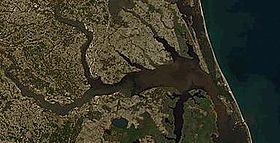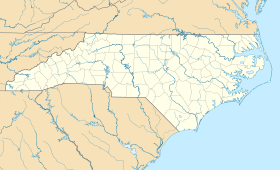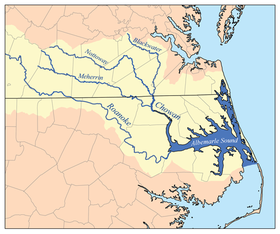- Albemarle Sound
-
Albemarle Sound (Albemarle Sound)
Vista de satélite del Albemarle SoundUbicación geográfica Océano Océano Atlántico Continente América del Norte Ubicación administrativa País (es)  Estados Unidos
Estados UnidosDivisión (es)  Carolina del Norte
Carolina del NorteCuerpo de agua Subdivisiones Roanaoke Sound y Croatan Sound (SE)
Currituck Sound (NE)Dimensiones Longitud 80 km Anchura máxima 8-23 km Accidentes geográficos Otros accidentes Bahía Chesapeake Otros datos Ciudades costeras Elizabeth City Primera exploración Ralph Lane (1585) Ríos que drenan Río Roanoke (612 km) y Chowan Coordenadas Coordenadas: Mapa de localización Geolocalización en Carolina del Norte Mapa del Albemarle Sound El Albemarle Sound[1] (a veces traducido por estrecho de Albemarle) (en inglés, Albemarle Sound) es una gran ensenada o bahía costera de la costa atlántica de los Estados Unidos, localizada al noreste de Carolina del Norte. Está protegida del océano Atlántico por el escudo que forman los Outer Banks y tiene cerca de 80 km de longitud y de 8 a 23 km de anchura.
Está comunicada con la bahía Chesapeake por medio de la Gran Ciénaga Dismal y del canal Albemarle y Chesapeake. Elizabeth City es su principal puerto.
El Albemarle forma parte de la ruta de navegación del Canal Intracostero del Atlántico.
El estuario fue explorado por Ralph Lane en 1585, y fue nombrado después por George Monck.
Véase también
Notas
- ↑ La voz inglesa «sound» no tiene traducción directa al español, aunque a veces se hace como estrecho o bahía. En geografía marina, un «sound» es un gran entrante de mar u océano, que es mayor que una bahía, más profundo que una cuenca marina y más amplio que un fiordo. A veces se puede identificar con un estrecho o canal entre dos masas de tierra.
Categorías:- Golfos y bahías de Estados Unidos del océano Atlántico
- Geografía de Carolina del Norte
Wikimedia foundation. 2010.



